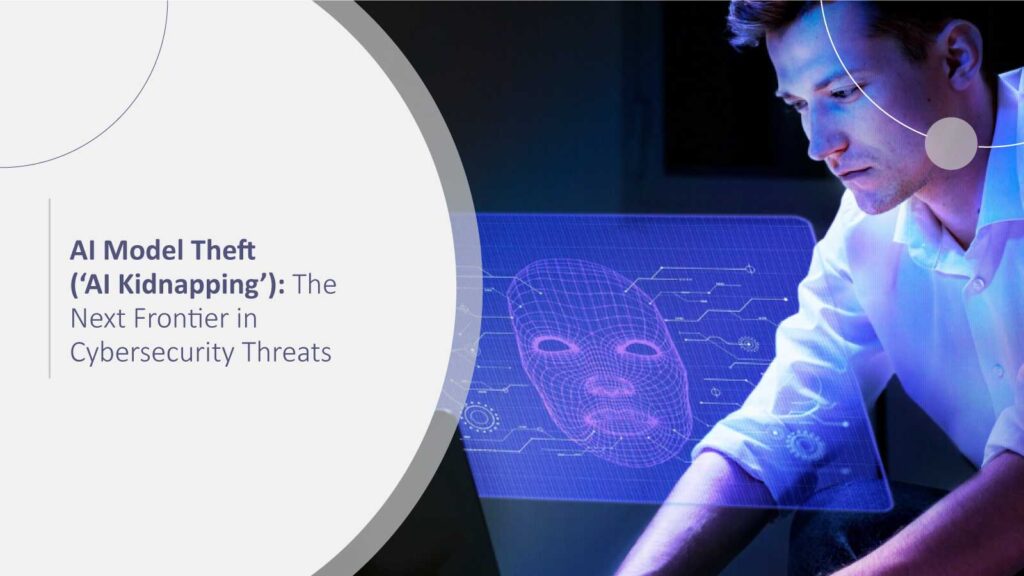Artificial intelligence is the foundation of contemporary business activity, driving everything from financial fraud to medical diagnosis and supply chain forecasting. But as AI models grow more sophisticated and valuable, a new type of cyber attack has arisen in the form of AI model theft, or “AI kidnapping.” The attack is on the very intellectual property that enables enterprise AI, enabling attackers to steal, replicate, or manipulate machine learning models.
To the world’s businesses, the stakes are actually massive. lost market advantage, reputational harm, and additionally billions on the line in prospective losses. In this article, we delve into what AI model theft is, how hackers do it, and why it is among the most significant cybersecurity challenges of the next decade.
Understanding AI Model Theft and Its Growing Relevance
AI Model Theft, or AI kidnapping, entails unauthorized copying, duplication, or modification of machine learning models. While data breaches pour out sensitive information, this type of attack kidnaps the trained algorithms and models themselves, proprietary assets at the core of AI innovation.
As per IBM’s 2024 Cost of a Data Breach report, the cost of an AI-related intellectual property theft can exceed $4.45 million per breach, a cost that will increase as AI is adopted on a larger scale. To industries such as finance, defense, and healthcare, these models represent not lines of code, but years of R&D investment, confidential data sets, and deliberate market positioning.
For instance, take the case of a bank with millions of customer transactions that have been used to train a fraud prediction model. If the attackers are able to steal that model, they can reproduce it, learn the vulnerabilities within it, and even devise fraud schemes to evade its detection capabilities. Worse still, the stolen model may end up in the hands of the competition or nation-state aggressors to provide them with an unfair market advantage.
How Attackers Carry Out AI Kidnapping
Attacked AI models often target weaknesses in model training, deployment, or access. Furthermore, Attackers employ various methods, ranging from simple to sophisticated, as follows:
1. Model Extraction Attacks
This entails continuously having an AI system estimate its decision-making. For instance, an attacker can feed thousands of image inputs to a vision model and observe the outputs. Gradually, they build a “shadow model” that can replicate the behavior of the original system. Google researchers have shown how extraction attacks can replicate commercial APIs with as much as 90% accuracy. It illustrates just how powerful this technique can be.
2. Adversarial Queries and Inference
Other attacks are not required to completely mimic the model. In these scenarios, the attackers carry out specially crafted queries to make inferences regarding the training set, model parameters, or even the sensitive model properties. An AI intended to learn medical images, for example, may unintentionally disclose patient-level information unless adversarial queries are under observation.
3. Insider Threats and Supply Chain Weaknesses
Not every AI kidnapping is external. Internally, people with high access to models can exfiltrate copies for profit or sell them on black markets. Moreover, inappropriately secured third-party vendors or open-source repos provide attack surfaces where attackers can insert malicious code or backdoors used later for stealing.
The expanding dark web black market for stolen AI assets is indicative of how bad this problem is. In a 2024 Darktrace report, the communities are openly trading stolen AI models and larger and larger language models (LLMs), which have exploded commercially in terms of value.
Implications for Industries and Businesses
AI model theft is not merely intellectual property loss; it translates to wider operational and reputation threats:
- Loss of Competitive Advantage: Organizations that spend millions on training models risk losing out when faced with pilfered copies used by competitors or even enemies.
- Bypassing Security Mechanisms: Pilfered security AI, including fraud detection or intrusion prevention models, enables attackers to reverse-engineer defenses and craft attacks that cannot be detected.
- Risk to Data Privacy: If the hijacked model had been trained on personal data, criminals could obtain personal data from its decision-making process.
- Regulatory and Legal Consequences: In highly regulated sectors such as healthcare or finance, an abducted AI model can result in compliance breaches, lawsuits, and fines.
A. An example was witnessed in 2020 when attackers were found to steal machine learning models from Microsoft Azure’s ML-as-a-service platform. Although mitigations were implemented hastily, they revealed how enterprise-grade platforms are not protected against AI kidnapping attacks.
Defense Against AI Model Theft
Fortunately, companies can counter their vulnerability to AI kidnapping with layered security and novel best practices:
1. Model Watermarking and Fingerprinting
Organizations can trace stolen models if they reappear elsewhere by embedding unique identifiers into AI models. Organizations like MITRE and DARPA are developing AI watermarking technology to improve IP protection.
2. Access Control and Query Monitoring
Restricting model access to authorized users and constant surveillance for erratic trends of queries can trap extraction attacks in the process. For instance, if a fraud-detection API is getting millions of calls from a risk-high IP address, that’s a warning sign.
3. Encryption and Secure Enclaves
Integrating models into secure enclaves, like Intel SGX, can make them more difficult for malicious actors to exfiltrate. End-to-end encryption, both at training and deployment, also minimizes risks.
4. Zero-Trust for AI Supply Chains
Companies must apply zero-trust practices to AI development pipelines. It authenticates each dataset, codebase, and vendor. Third-party AI tools must be audited regularly to prevent backdoors.
Being proactive not only shields intellectual property but also keeps regulators’, stakeholders’, and customers’ trust in AI systems intact.
Conclusion
AI model theft, or AI kidnapping, is the new great frontier of cybersecurity threats. Contrary to typical breaches, these attacks target the very soul of enterprise innovation in the guise of algorithms and models that create a competitive edge. As monetary losses due to intellectual property piracy total unprecedented amounts and rivals become increasingly clever, corporations have no choice but to act now and protect their AI assets. From model watermarking to zero-trust pipelines, defensive weapons are on the table. It’s the sense of urgency for implementing them that counts. For companies staking their future on AI to chart their trajectory, model protection is no longer a choice; it’s survival.
FAQs
1. What is AI model theft or AI kidnapping?
AI model theft is when criminal hackers steal or copy a machine learning model illegally, violating intellectual property and business security.
2. How do attackers steal AI models?
Typically, these include model extraction, adversarial queries, insider leaks, and vulnerable supply chains.
3. Why is it risky for businesses to steal AI models?
It can cause loss, security bypass, data privacy threats, and compliance issues, while compromising competitive advantage.
4. Can the kidnapped AI models be traced?
Yes. New methods, such as model watermarking and fingerprinting, enable organizations to identify unauthorized use of their AI models.
5. How do organizations prevent AI Model Theft?
Organizations should apply access controls, query monitoring, utilize secure enclaves, and maintain zero-trust policies throughout AI pipelines.
To participate in upcoming interviews, please reach out to our CyberTech Media Room at sudipto@intentamplify.com.







